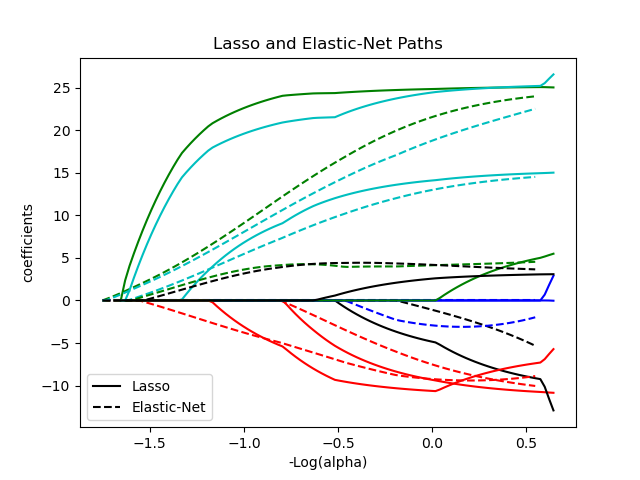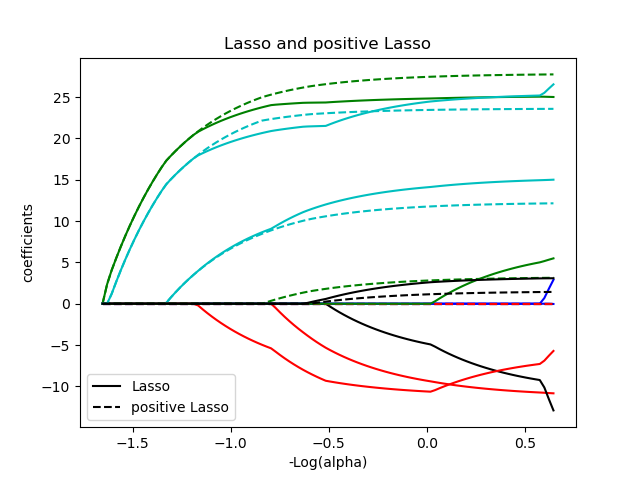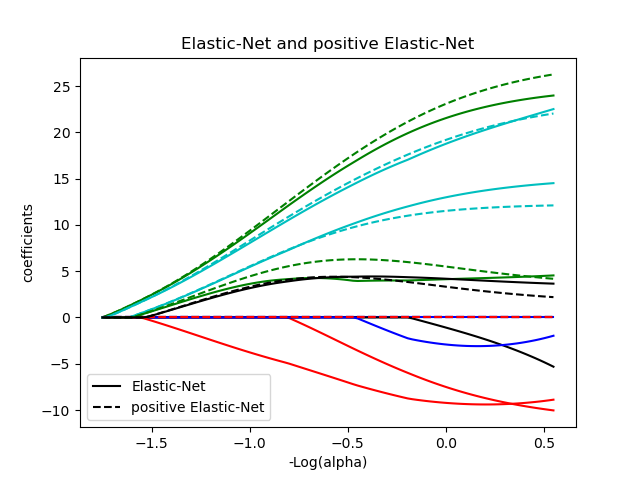W3cubDocs
/scikit-learnLasso and Elastic Net
Lasso and elastic net (L1 and L2 penalisation) implemented using a coordinate descent.
The coefficients can be forced to be positive.
Out:
Computing regularization path using the lasso... Computing regularization path using the positive lasso... Computing regularization path using the elastic net... Computing regularization path using the positive elastic net...
print(__doc__) # Author: Alexandre Gramfort <[email protected]> # License: BSD 3 clause from itertools import cycle import numpy as np import matplotlib.pyplot as plt from sklearn.linear_model import lasso_path, enet_path from sklearn import datasets diabetes = datasets.load_diabetes() X = diabetes.data y = diabetes.target X /= X.std(axis=0) # Standardize data (easier to set the l1_ratio parameter) # Compute paths eps = 5e-3 # the smaller it is the longer is the path print("Computing regularization path using the lasso...") alphas_lasso, coefs_lasso, _ = lasso_path(X, y, eps, fit_intercept=False) print("Computing regularization path using the positive lasso...") alphas_positive_lasso, coefs_positive_lasso, _ = lasso_path( X, y, eps, positive=True, fit_intercept=False) print("Computing regularization path using the elastic net...") alphas_enet, coefs_enet, _ = enet_path( X, y, eps=eps, l1_ratio=0.8, fit_intercept=False) print("Computing regularization path using the positive elastic net...") alphas_positive_enet, coefs_positive_enet, _ = enet_path( X, y, eps=eps, l1_ratio=0.8, positive=True, fit_intercept=False) # Display results plt.figure(1) ax = plt.gca() colors = cycle(['b', 'r', 'g', 'c', 'k']) neg_log_alphas_lasso = -np.log10(alphas_lasso) neg_log_alphas_enet = -np.log10(alphas_enet) for coef_l, coef_e, c in zip(coefs_lasso, coefs_enet, colors): l1 = plt.plot(neg_log_alphas_lasso, coef_l, c=c) l2 = plt.plot(neg_log_alphas_enet, coef_e, linestyle='--', c=c) plt.xlabel('-Log(alpha)') plt.ylabel('coefficients') plt.title('Lasso and Elastic-Net Paths') plt.legend((l1[-1], l2[-1]), ('Lasso', 'Elastic-Net'), loc='lower left') plt.axis('tight') plt.figure(2) ax = plt.gca() neg_log_alphas_positive_lasso = -np.log10(alphas_positive_lasso) for coef_l, coef_pl, c in zip(coefs_lasso, coefs_positive_lasso, colors): l1 = plt.plot(neg_log_alphas_lasso, coef_l, c=c) l2 = plt.plot(neg_log_alphas_positive_lasso, coef_pl, linestyle='--', c=c) plt.xlabel('-Log(alpha)') plt.ylabel('coefficients') plt.title('Lasso and positive Lasso') plt.legend((l1[-1], l2[-1]), ('Lasso', 'positive Lasso'), loc='lower left') plt.axis('tight') plt.figure(3) ax = plt.gca() neg_log_alphas_positive_enet = -np.log10(alphas_positive_enet) for (coef_e, coef_pe, c) in zip(coefs_enet, coefs_positive_enet, colors): l1 = plt.plot(neg_log_alphas_enet, coef_e, c=c) l2 = plt.plot(neg_log_alphas_positive_enet, coef_pe, linestyle='--', c=c) plt.xlabel('-Log(alpha)') plt.ylabel('coefficients') plt.title('Elastic-Net and positive Elastic-Net') plt.legend((l1[-1], l2[-1]), ('Elastic-Net', 'positive Elastic-Net'), loc='lower left') plt.axis('tight') plt.show()
Total running time of the script: (0 minutes 0.391 seconds)
Download Python source code:
plot_lasso_coordinate_descent_path.py
Download IPython notebook:
plot_lasso_coordinate_descent_path.ipynb
© 2007–2016 The scikit-learn developers
Licensed under the 3-clause BSD License.
http://scikit-learn.org/stable/auto_examples/linear_model/plot_lasso_coordinate_descent_path.html


